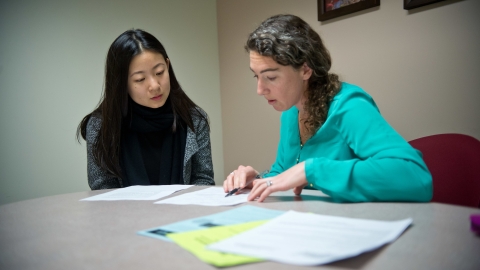
Bucknell Career Center Offers Tips for Job or Internship Video Interviews
April 15, 2020
During a normal semester, the Center for Career Advancement's Megan Wolleben (right) helps review student résumés and hosts mock interviews. While the campus is closed during the COVID-19 outbreak, Wolleben and her team have moved those services online. Photo by Bucknell University
Typically in-person activities like meetings, game nights and high-level college courses have moved to videoconferencing platforms for the foreseeable future, but interviews for jobs and internships have been conducted online for years.
Even before the outbreak of the coronavirus (COVID-19), many employers used videoconferencing to complete initial candidate screenings. Some even used Skype, Zoom or Google Hangouts to conduct mid- to late-round interviews with applicants from around the world.
Now that all interviews will be conducted by video for the time being, we reached out to Bucknell's Center for Career Advancement for advice on how students can put their best virtual foot forward.
"An interview is an interview, so all the general rules apply," says the center’s Megan Wolleben. "You want to research the company, read the job description, know your résumé and be ready to answer common interview questions. You'll also want to prepare some of your own questions to ask the interviewer."
This is some of the advice they have for students with an upcoming video interview.
Ten Tips for Job or Internship Video Interviews
- Practice. Write a list of questions the interviewer might ask and practice answering them. Focus on eliminating or reducing your use of filler words like "um" or "like." For additional help, Bucknell students have access to the resources of Big Interview, an online interview preparation system, and can schedule mock interviews with the Center for Career Advancement.
- Test your technology. Start by testing the interview software. Do you have the latest version, or does the program need an update? Then check your hardware, making sure your microphone, speakers/headphones and camera work flawlessly. Once everything is set up, try a test call with a friend or family member. Verify that they can hear and see you well. In the hours before the interview, restart your computer and close all unnecessary programs.
- Position yourself to win. Body language matters over video, too. Sit up straight, and place the camera at eye level. If you're using a phone (which is less desirable but OK if that's all you have) prop it up horizontally and remain seated — don't walk around. If you're using a laptop, place it on a table or desk — not on your lap.
- Dress for success. Dress for a video interview the same way you'd dress for an in-person interview. Yes, that includes wearing dress pants or a dressy skirt. You never know if you might need to get up or reach for something. For your shirt or top, avoid busy patterns that won't look good on screen.
- Prepare your environment. Think about your background, which should be clean and not distracting. If this isn't possible, consider using one of the Bucknell Zoom backgrounds available here. Make sure your face is well lit and that there's not a bright light behind you. Turn off the TV and music, and let your roommates, friends and family members know you'll need quiet. Put pets outside or in another room.
- Show up early. Verify the date and time of the interview. There's a chance the company is located in a different time zone, so be sure to adjust accordingly.
- Stay focused and visibly engaged. The interviewer will see your face the whole time, so practice active listening by nodding your head, smiling and demonstrating your enthusiasm about the position. Set your phone to silent. Keep your focus on the screen, and look directly into the camera often. This might feel strange to you but will give the interviewer the impression of eye contact. If you want to take notes, do so in a notebook so it's obvious you're writing and not typing.
- Be prepared with visuals. It's OK to place some sticky notes around your screen with a few points you want to hit on, but don't rely on a cheat sheet with full answers — it will be obvious that you're reading. Be ready to show examples of your work or a portfolio — either physical examples or by sharing your screen. If there's a chance you'll share your screen, close all other programs and browser tabs except for the ones you need.
- Go slow. When you're talking, take your time. If you often speak with your hands, try to minimize broad gestures that might become choppy on video. Video calls often have a delay, so it's essential to speak clearly at an audible volume. But don't shout. To help yourself be heard, consider using an external microphone or headphones with a built-in mic.
- Send a thank-you email. This one applies to in-person and video interviews, but be sure to send a thank-you email to the interviewer. These work best when you personalize them by including specific details about the interview — something the interviewer shared that you found especially interesting or appealing.
Typically, Wolleben and her colleagues at the Center for Career Advancement offer in-person appointments where students can have their résumés reviewed or participate in a mock interview.
While the campus is closed, the team has moved those same services to phone or Zoom. Interested students can schedule an appointment using their myBucknell login.
